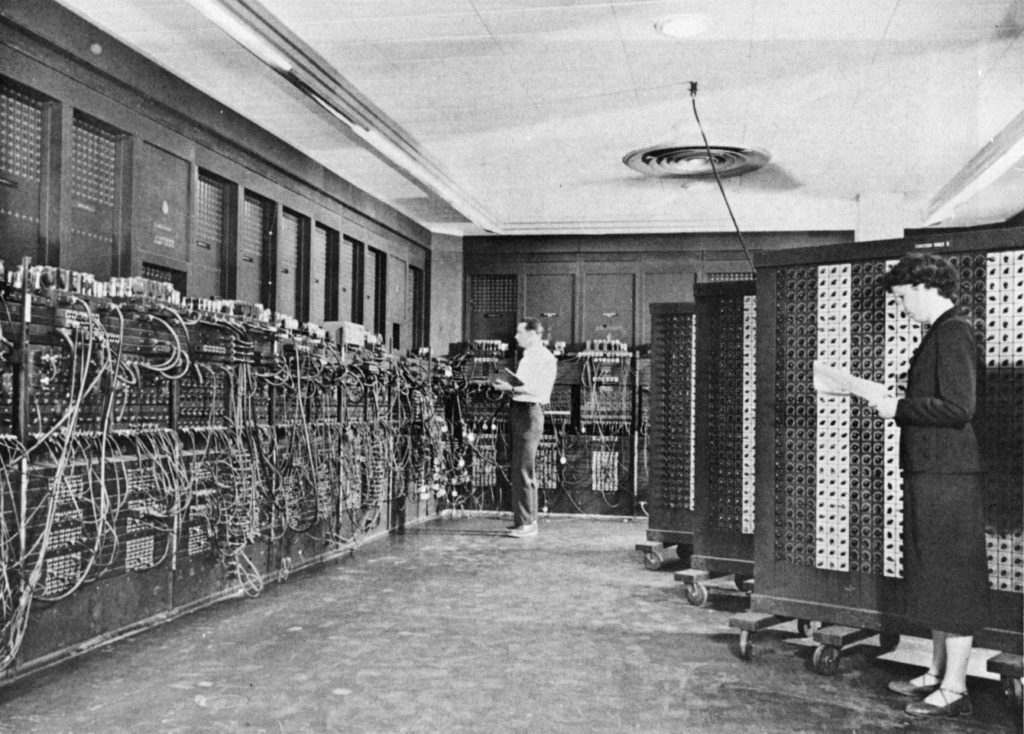Women’s contributions to modern technology have largely gone unacknowledged. However, female minds powered some of the most significant advancements in computing.
Take for example, the world’s first computer. As a result of gender stereotyping, if we are asked to visualize the first computer programmers, we tend to think of figures like Bill Gates or Steve jobs, not a group of women in the 1940s. It is a little-known fact that the world’s first computer was, in fact, programmed by six women.
This is what you need to know about the history of women in computing and technology—including the women who coded the world’s first computer, the evolution of legal protections for women in the workplace, and the role of women in today’s tech landscape.
ENIAC: The World’s First Computer
The Electrical Numerical Integrator and Computer, known as “ENIAC,” was completed in 1945. It was the world’s first electronic computer. Unlike modern-day computers, it had no memory and could not store equations and calculational processes. Engineers needed a team of humans capable of completing these complex equations by hand to hard-program the sequences into ENIAC.

The six young women selected for this job were Jean Jennings, Frances Spence, Marlyn Wescoff, Ruth Lichterman, Frances Holberton, and Kathleen McNulty. The group had no manuals or precedents to follow. This means they had to learn by memory the mechanics of the 30-ton machine with its 6,000 manual switches, 10,000 capacitors, and 70,000 resistors.
The group broke down massive, complex mathematical sequences into simplified, sequenced steps. They effectively hand-programmed ENIAC so that this pioneering computer could work through simple equations. The result of their input was revolutionary. Thanks to the group’s contributions, ENIAC took 30 man hours’ worth of ballistic equations, completing them in seconds.
The Erasure of Women’s Contributions
Just months after the end of World War II, in February 1946, ENIAC was revealed to the public. Despite their groundbreaking contributions, none of the six female programmers were named. Instead, two male engineers received all of the credit. The six women who played pivotal roles in developing ENIAC were overlooked for nearly 70 years. Indeed, they were not even invited to the ENIAC project’s 50-year anniversary celebration.
It was not until the 1980s, when a computer science major named Kathy Kleiman started looking into the role of women in computing that the group’s contribution came to light. According to Kleiman, when she asked a professor who the six women were, he explained that they were probably models who posed with the ENIAC machine to make it seem more alluring.
She did not take this explanation at face value. Instead, Kleiman and a group of volunteers spent the next 20 years tracking down the six women in what came to be known as the ENIAC Programmers Project. They found that while history had forgotten the six women, each of the “ENIAC 6″ went on to make further contributions to the field of computing. Now that these women have finally received the recognition that they deserve, they can inspire the next generation of female programmers.
Women’s Legal Rights in the Workplace
It has taken years for women to receive not only professional recognition, but basic workplace rights. For example, it was not until 1968 that the Equal Employment Opportunity Commission stated that it is unlawful to separate job listings by gender.
Similarly, the Pregnancy Discrimination Act 1978 makes it illegal for employers to dismiss women, or pass them up for promotion, because they are pregnant. Before this law was implemented, many women were terminated from professional positions to save employers maternity leave payments and increased healthcare costs.

The Meritor Savings Bank v Vinson 1986 Supreme Court case set a legal precedent protecting working women across America. It established that repeated advances or sexual references in the workplace creates a hostile environment. However, this law did not stop sexual harassment from occurring. The recent #MeToo campaign brought international attention to the ongoing issue of workplace sexual harassment.
Women are doing better than ever before, particularly in terms of education. In fact, approximately 5 percent more women enroll in college than men. These figures do not translate to more women in tech, however. Only 18 percent of computer science majors are female. Engineering faces a similar problem. Just 11 percent of practicing engineers are women.
The Future of Women in Computing
Attitudes are changing slowly but surely. Companies around the world are realizing the benefits of diversity. Studies show that incorporating more women into an organization’s management structure increases revenue. Statistics published by the Peterson Institute for International Economics show that, of 22,000 participating companies, the most profitable were gender diverse.
As public hunger for new technology continues to grow, so does the deficit in skilled workers. According to research by Delloite, American women account for $4.3 trillion in consumer spending. No one understands the needs of a woman like a woman. Companies throughout the United States and globally are coming to recognize this vastly untapped pool of talent that could help their businesses to thrive.

 Joanna (Jo) Riley is an entrepreneur, investor, and advocate in technology, and is currently the CEO and Co-Founder of Censia. Jo has a highly experienced background in building and scaling companies, which she attributes to her deep passion for people and building technologies that allow people to be their best selves. She brings her wide knowledge of the industry to better transform the way enterprise companies hire talent. You can connect with Joanna Riley at @joannakiddriley on
Joanna (Jo) Riley is an entrepreneur, investor, and advocate in technology, and is currently the CEO and Co-Founder of Censia. Jo has a highly experienced background in building and scaling companies, which she attributes to her deep passion for people and building technologies that allow people to be their best selves. She brings her wide knowledge of the industry to better transform the way enterprise companies hire talent. You can connect with Joanna Riley at @joannakiddriley on